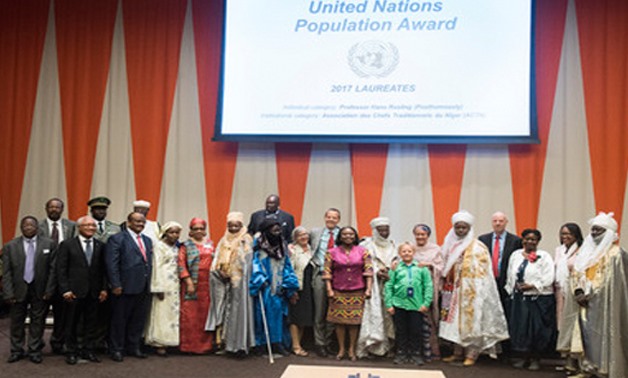
UN Population Award Ceremony June 32, 2017 - Courtesy of UN Official Website
CAIRO – 25 June 2017: The latest findings and forecasts of the United Nations annual population survey released on June 21 show that there are more men than women globally (102 men for every 100 women). The survey also predicts that the number of persons over 60 will exceed 1 billion for the first time in 2018, children under 15 years make up about one quarter of the world’s inhabitants and the world’s population will reach 8 billion in 2033.
In June 2017, the world’s population stands at almost 7.6 billion, increasing at a rate of 1.1 percent annually. This equates to an extra 83 million people every year, with the median age of the world’s population at 30.
The UN survey predictions indicate that until 2050, ten countries will account collectively for more than half the global population growth - India, Nigeria, the Democratic Republic of Congo, Pakistan, Ethiopia, Tanzania, the United States, Uganda, Indonesia and Egypt.
China with 1.4 billion inhabitants and India with 1.3 billion inhabitants remain the two most populous countries. However, the survey indicates that around 2024, India is expected to overtake China to become the world’s most populous nation.
The survey indicates that large movements of migrants between regions, often from low and middle income countries toward high income countries, is a continuing trend. The volume of the net inflow of migrants to high-income countries from 2010-2015 (3.2 million per year) represented a decline from a peak attained in 2005-2010 (4.5 million per year). The report highlights the major impact of the Syrian refugee crisis on levels and patterns of international migration that has affected several countries. The estimated net outflow from the Syrian Arab Republic was 4.2 million persons in 2010-2015. Most of these refugees traveled to Syria’s neighboring countries, contributing to a substantial increase in the net inflow of migrants particularly to Turkey, Lebanon and Jordan.
Egypt’s demographic profile includes key indicators from the period 1950-2100. The charts below illustrate some of these demographic indicators and are taken from the UN Department of Economic and Social Affairs Population Division publication ‘World Population Prospects: The 2017 Revision.’

Total Population by Variant

Total Population by broad age group

Total Fertility

Mortality Under Age 5

Life Expectancy at Birth by Sex
.jpg)
Life Expectancy at Birth Both Sexes Combined
According to the survey, the total population of Egypt is 97,553 million (49,325 males and 48,228 females). The age group of 0-14 represents 33 percent of the population and the age group 25-59 represents 42 percent. Egypt ranks 14 out of 27 countries that account for approximately 75 percent of the world’s population according to population size.
The 2017 Revision of World Population Prospects is the twenty-fifth round of official UN population estimates and projections prepared by the Population Division of the Department of Economic and Social Affairs of the UN Secretariat. The main results are presented in a series displaying key demographic indicators for each development group, income group, region, sub-region and country or area for selected periods or dates within 1950-2100.
The report provides a comprehensive review of global demographic trends and prospects for the future. The information is essential to guide policies aimed at achieving the UN’s new Sustainable Development Goals.





.jpg)
Comments
Leave a Comment